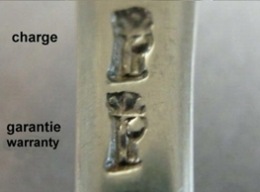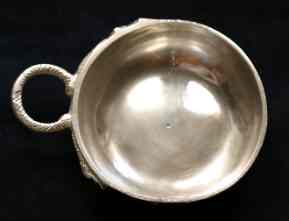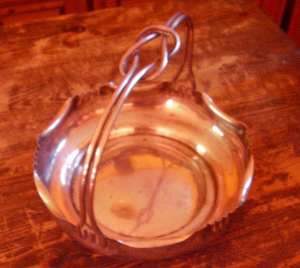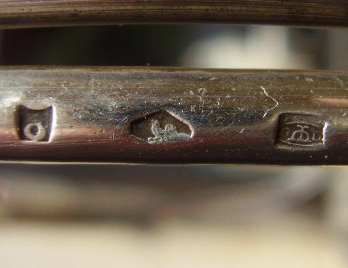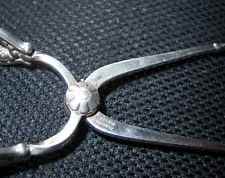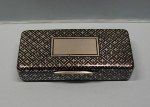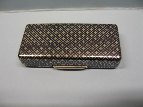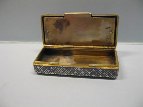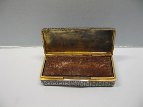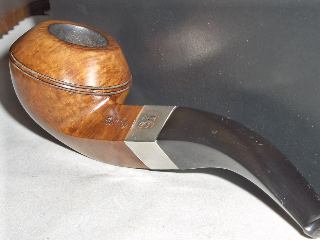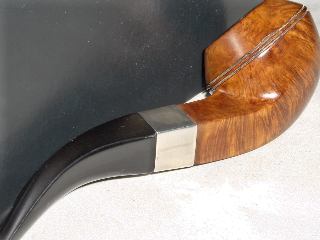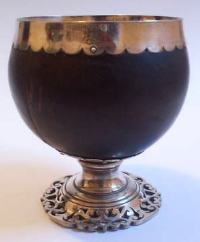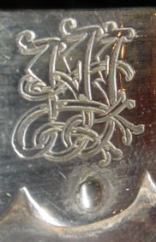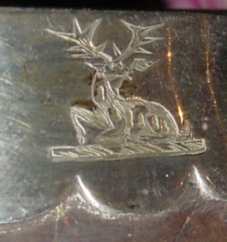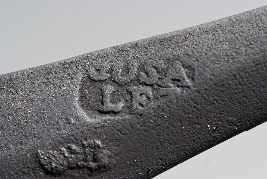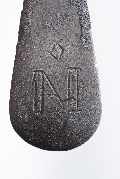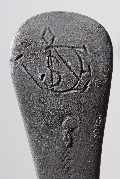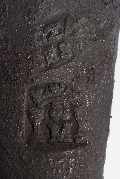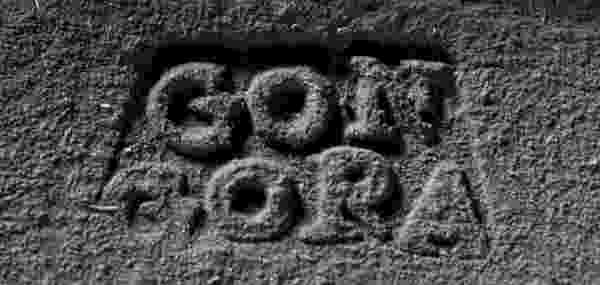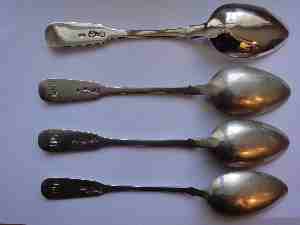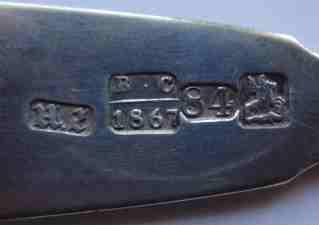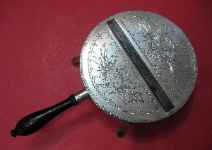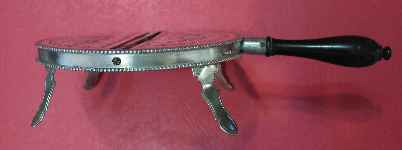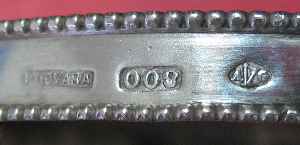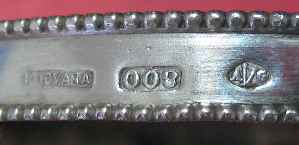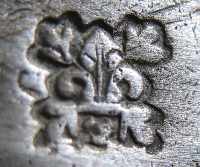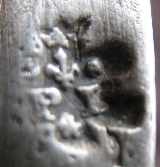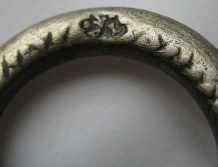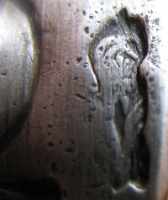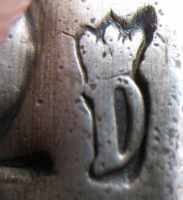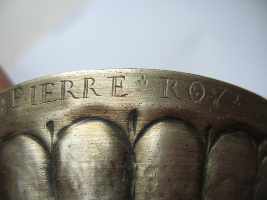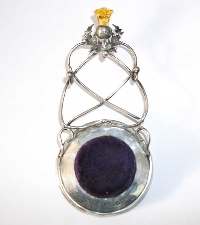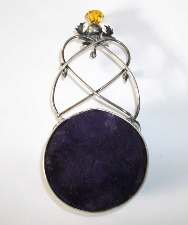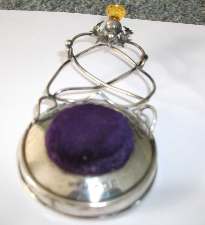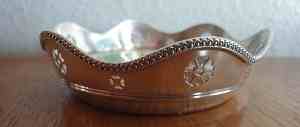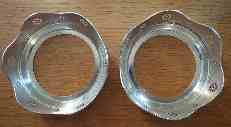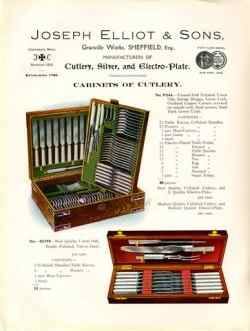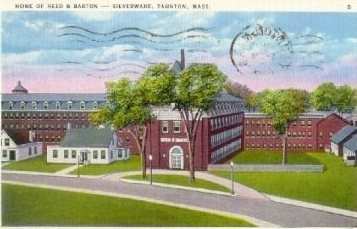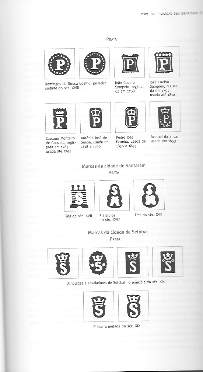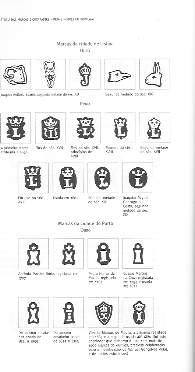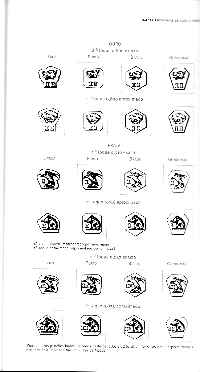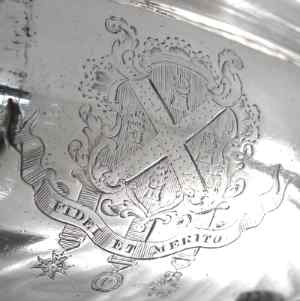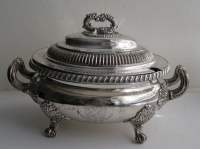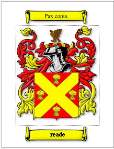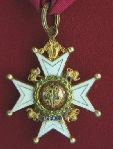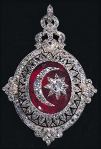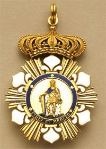 newsletter
# 74 July 2010 newsletter
# 74 July 2010www.ASCASonline.org SITE MAP email: silverassociation@yahoo.it |
||||||||||||||||
New membersWelcome to new ASCAS members:Daryl Adams - The Netherlands
|
|
top page -
page map |
Members' Window # 74
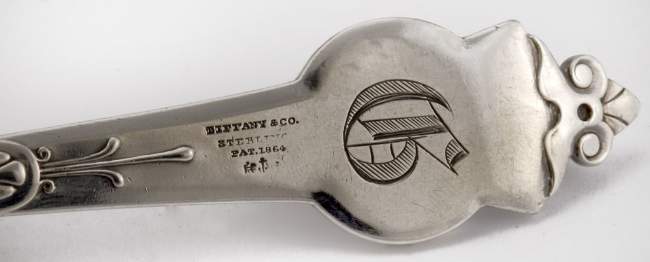
Les Salvage presents:
|
Mail to ASCAS: e-mail silverassociation@yahoo.it
Stewart Hersey writes:
... I have made a short film about making a silver candlestick
which I would like to share with your members via a link to it
on my website.
It shows the traditional method used to make a spun candlestick,
and I am sure it would be interesting for them.
Thank you,
Stewart Hersey
Stewart Hersey is the Managing Director of M. C. Hersey &
Son Ltd.
The business started as Mills and Hersey around 1970 (mark M&H).
In present days the firm is active at 87 Railway Road,
Teddington, Middlesex.
The video follows, step by step, the traditional manufacture of
a silver candlestick.
Follow this link to see the video
http://www.hersey.co.uk/information-page-2
Giorgio Busetto
Haroune Toumani writes:
...I need help to identify the mark of this basket.
Thanks for your help
Haroune Toumani
The marks belong, presumably, to a German maker (silver
plate).
I’m sorry, but I’m unable to identify the maker.
Giorgio Busetto
Ludo D’Haese writes:
...Is it possible to identify the maker on this German mark?
Ludo D’Haese
The maker is Wilhelm Rentrop, Altena i. Westfalen,
Werkstatte fur Kirchengerate.
Giorgio Busetto
Allen Carlson writes:
...I have a question about a pair of Georg Jensen "Blossom"
sugar tongs I just bought.
I seem to remember reading that the tongs should have a spring
that kept the tongs open. The tongs that I bought do not have a
spring action.
Do you think that they are defective?
Thanks,
Allen Carlson
Bruno Bruni writes:
...In my attachment I forward the images of a French niello
silver, box shaped, vesta case. Decorated on the exterior with a
cross-weave niello pattern. The hinged lid, when opened, reveals
a striker plate (which is also hinged). The matches are kept
below the striker plate.
Dimensions 54 x 24 x 12 mm, weight 38,4 grams.
Hallmarks: Small guarantee mark (boar's head) and an
unidentified (M//D) makers mark.
My question is: can someone identify the maker?
Thanks,
Bruno
Piero Eduardo writes:
...another question about the silver ring of a pipe marked B &
Co into a rectangle, London 1913. On the briar the pipe bears
the mark "Bewlay". Bewlay was a well known chain of English pipe
stores owned by Salmon & Gluckstein active from the beginning of
the 20th century until the 1980s.
I'd wish to know any possible information about the silver mark.
Thanks in advance
Piero Eduardo
B&Co is the hallmark of Bewlay & Co Ltd. Some further
information is available in the
"Tobacconists, Pipe Makers and Pipe Mounters" section of my
web site
Giorgio Busetto
Eddy Huysmans writes:
...The little note "Crests and Mottoes of British, Irish and
Scottish families as engraved on silver items" made me think of
a coconut cup I bought about a year ago.
It has no silver marks, but I think it is British, Irish or
Scottish from about 1800.
Maybe someone can give me some information about the crest or
the monogram.
Sincerely Yours,
Eddy Huysmans
Mario Galasso writes:
...I'm working on a group of Mexican silver of the eighteenth
century on behalf of a friend of the French archaeologist DRASSM
(French Government) who is digging a wreck near Montpellier
(Joanne Elisabeth, sunk in 1755).
While I have identified almost all the marks, I am missing the full
name and details of the silversmith.
The marks Gosa / LEZ and Goza / LES relate to the assayer (ensayador
mayor) Don Diego de la Cueva Gonzales, Ciutad Méjico, 1731-1777
according to some, others are between 1731 and 1778 or 1788, or
between 1741 and 1775 or between 1733 and 1778. I need to know
the periods of use of his three punches (Goza / SLE or Gosa / or
GÑZ LEZ).
The problem is: the brand GON / GORA attributable to silversmith
Gongora, a name common enough in Mexico at that time. I need to
further refine the date when this silversmith was active
(between 1731 -top mark Gonzales- and 1755 -year of the
sinking-).
Would be also useful to know the history of the marks 'Gonzales'
to restrict the chronological range.
Gongora should have worked in Ciudad Méjico (Mexico City).
Can you help?
Mario Galasso
Geldolph Everts writes:
...When in Armenia, I purchased four spoons, first three of the
same set (with Armenian initials engraved), then much later one
additional spoon of a different set. All four have the same
marks. The assayer is Victor Savinkov, but in existing reference
works I have not found the master; the Cyrillic letters appear
to be
 .
.
I was wondering if Postnikova could help out. She will be
updating her wonderful book all the time ( I have the 1995
edition) with more recent discoveries, so I might be lucky...
With many thanks, as always, and kind regards,
Geldolph Everts
Claudio Morelli writes:
...I believe that this uncommon object is a truffles' slicer.
What I don't know is who is the maker (Giuseppe Giovara?) and
when he was active.
Claudio Morelli
A similar mark (a harp between letters G and G) was used
by Giuseppe Giuvara, Torino ....1822-1824...
It's probable that, later, the symbol was maintained and used by
a descendant of this silversmith (anyway, after 1870,
considering that the piece is marked '800').
Giorgio Busetto
Eddie Robinson writes:
...I have a question if you can help: I have a pair of sugar
tongs with the following mark.
Could you shed some light on it for me?
Have a great day.
Eddie
The maker of your sugar tongs is, possibly, Edwin Howard
& Son, 90 Pond Street, Sheffield, active 1863-1870. Further
information is available in my web site at
http://www.silvercollection.it/electroplatesilverHdue.html
Giorgio Busetto
Jean-Christophe Malguy writes:
...I contact you because I can not identify these marks.
I send you some pictures. Photo # 1: I think that is a hallmark
of Paris "discharge", period 1717-1722
Photo No. 2 and 3: silversmith's mark, initials P and L over a
star under a fleur-de-lys with a crown and surrounded by two "grains"
(perhaps Louis Ponay?)
Photo No. 4: what I believe to be a poincon de charge (A
surmounted by a crown) Paris 1717-1722
Photo No. 5: D crowned:I don't know what is
Jean-Christophe Malguy
Any help will be appreciated
Giorgio Busetto
Replies to questions
Helen receives these
answers to the question about her unidentified item
(see June 2010 Newsletter)
Pamela Coates writes:
This looks like a ladies pocket watch holder, or rings,
depending upon the size of the three hooks. The center is for
hatpins.
I have had items like this over the years
Thanks for sharing your unusual shaped holder
Pamela Coates
Carolyn Meacham writes:
The item below above is a hanging pin cushion / ring holder. It
could also be used for hat pins.
I would be willing to bet that the maker's mark is ALLtd (Adie
Lovekin, Ltd).
They made a lot of these.
Best,
Carolyn
Geldolph Everts
receives this answer to the question about his silver holders/stands
(see June 2010 Newsletter)
Simon Buxton writes:
I can throw a little light on the glass holders submitted
by Geldolph Everts.
The number he queries (Rd 655681) is a national British
Registered Design number introduced in 1884 and used up until
around 1932 - a sort of copyright. His number was issued in 1917
and he is quite close in suggesting it was a pattern number.
As a rough guide the number 300,000 was issued in 1900. The
number is a guide to when the design was registered, but not the
date of an individual piece, though in this instance we have a
hallmark date letter. It covered a range of decorative goods
including ceramics and wasn't limited to silver ware.
Simon Buxton
Neil Hodgson
receives this comment about the marks of his reliquary
(see April 2010 Newsletter)
David Mckinley writes:
As my particular field of research has been early English
hallmarking my eye was caught by the marks on Neil Hodgson’s
reliquary in the April newsletter which, at first glance, would
appear to be English.
On closer examination however these marks cannot be identified
as any that I have come across before and I therefore tried to
place them in some other country. This I have been unable to do
although if any fellow member can do so the problem will be
solved.
In the absence of any current alternative therefore I offer the
following hypothesis:
The two centrally placed marks would appear to be the English
lion passant guardant and an English date letter. The two other
marks I have been unable to identify.
There were several years in which the upper case letter ‘H’ was
used in London but the most likely year in this case I suggest
is 1723 although the punch outline is wrong for this date. The
outline to the lion is too distorted to be sure of but the
absence of the leopard’s head is suspect although it was omitted
from small work such as teaspoons at this date.
English reliquaries are somewhat uncommon since they are usually
of Roman Catholic origin and relate to a period when that faith
was outlawed in England.
I have come across a communion cup in a Roman Catholic Church
which has no hallmarks but is struck three times with the
maker’s mark and he was Jewish. It can be dated to 1745 by the
inscription under the foot.
If Neil’s reliquary is English my belief is that it was, like
the communion cup, made for a recusant (editor's note: a person, esp.
a Roman Catholic, who refused to attend the services of the Church
of England) probably in the early
18th century and that the marks on it are false and were made to
give the appearance of those current at the time.
The unrecognisable marks were struck because a piece of this
date would be expected to carry four marks, the additional ones
being the maker’s mark and the leopard’s head. Presumably this
maker did not wish to be identified.
This is only a theory and I am open to any other suggestions.
David Mckinley
SILVER FROM SILESIA 1871-1945
A temporary exhibition from 27th March - 3rd October 2010 in the Stiftung Schlesisches Museum zu Goerlitz S.b.R., GOERLITZ (Germany)
The foundation of the German Empire in 1871 led to an
economic upturn from which Silesia's gold and silver
manufacturers also benefited. This exhibition is the first
attempt to display the wide range of articles produced by the
many workshops and shops which appeared at that time in Silesian
towns. We are grateful for numerous loans from public and
private collections in Germany and Poland without which this
exhibition would not be possible.
Visitors will be able to admire an impressive variety of coffee
and tea services, candelabras, goblets, plates and trays, prizes
and military memorabilia, chalices, ciboria and monstrance's, as
well as an array of cutlery, including a surprising amount of
individual pieces designed for special purposes and for special
occasions:
see at http://www.schlesisches-museum.de/Temporary-Exhibition-Si.3738.0.html
The exhibition can only be seen in Görlitz, and is accompanied
by an illustrated catalogue with a list of brand names and
descriptions of the then most important Silesian manufacturers.
The soft bound catalogue includes some black and white, and many
colour photographs, detailed descriptions, and measuring of all
120 shown objects.
Rainer Lemor, a very engaged descendant from Julius Lemor,
describes there also 13 of the then active companies in details
of history, and production program. Also he shows 220 maker's
marks and trade marks; with indication of where described, and
possible timeframe of use.
Included is also a list of literature.
If a visit is impossible during exhibition, but also for
preparing a visit, the catalogue (ISBN 978-3-9813510-2-6) could
be ordered on line through the Museum shop:
see at: http://www.schlesisches-museum.de/Publikationen-zu-Sondera.1984.0.html
Unfortunately the text is in German and Polish only, but
pictures and marks can be easily "read" and understood by anyone
interested in the matter.
Address: Stiftung Schlesisches Museum zu Goerlitz S.b.R.
Untermarkt 4
D-02826 Goerlitz / Germany
Tel. +49 3581 8791 0
Fax +49 3581 8791 200
e-mail: kontakt@schlesisches-museum.de
www.schlesisches-museum.de
Thanks to Oskar M. Zurell for his information
"A PAGE per MONTH"
In this column we present a page
obtained from makers' brochures, books, auction catalogs,
advertising or whatever other printed paper, related to silver,
that may be of interest for ASCAS members.
The images will be published at a "low resolution" level and for
private and personal use only
"A WORD per MONTH"
In this column we
present an abstract from a page of the "What is? Silver
Dictionary"
courtesy of

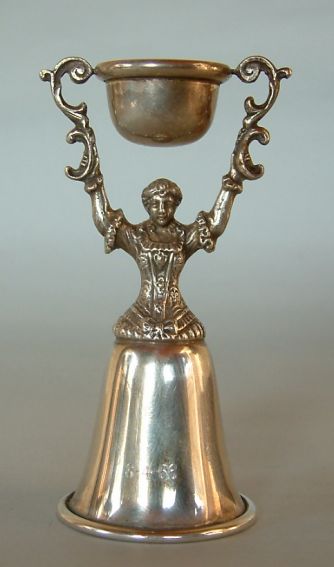
|
WAGER CUPThe
origins of these cups are 'Jungfraubecher' made in
Germany (Nuremberg) around 1565 and in use for all of the 17th
century. The cup has the look of a young girl with a
wide long skirt in the form of a cup supporting over her
head a smaller swivelling cup.
|
"A SILVERSMITH per MONTH"
In this column
we present marks, information and history of silversmiths and
silver manufacturers.
This column is published under the kind permission of Giorgio
Busetto's website 
REED & BARTON: YEAR'S MARK SYMBOLSThe Reed & Barton story
began in 1824, when Isaac Babbitt created a new metal
alloy - "Britannia metal" - in his Taunton,
Massachusetts pewter shop.
|
"A BOOK ON MY SHELF"
In this column we present books, new
or ancient, dealing with silver in all its aspects (history,
marks, oddities...). This isn't a "book review" but only a fair
presentation of some useful "tools" that anyone may have in the
shelf of his bookcase.
ASCAS members are invited to contribute to this column
(click to enlarge images)
The "book on my shelf" of this month presents:
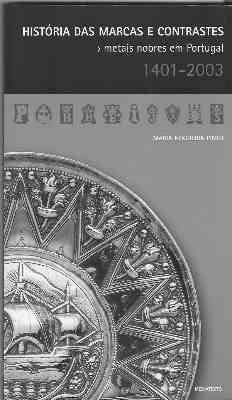
|
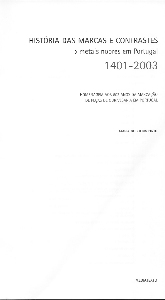
|
HISTORIA DAS MARCAS E CONTRASTES
metais nobres em Portugal 1401-2003 by
|
"A CREST per MONTH"
In this column we present images and descriptions of Crests and Mottoes of British, Irish and Scottish families as engraved on silver items.
Closing our July 2010 edition of ASCAS Newsletter I hope you have appreciated its content.
Your comments, suggestions and advice will be of great help.
My thanks to Bruno Bruni, Simon Buxton, Allen Carlson, Michael Carter, Ludo D’Haese, Jayne Dye, Piero Eduardo, Geldolph Everts, Mario Galasso, Christophe Ginter, Stewart Hersey, Eddy Huysmans, Jean-Christophe Malguy,Claudio Morelli, Eddie Robinson, Les Salvage, Haroune Toumani, Oskar M. Zurell for their invaluable contributions.
Giorgio Busetto
Secretary
ASCAS is a community of people having a common
interest in antique silver.
|
